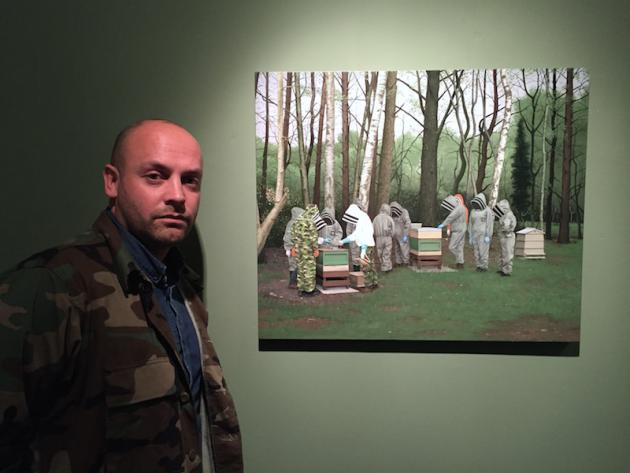It’s not so rare to find that the ideas to be unpacked behind explicitly conceptual art turn out, when you examine them, to be rather thin. John Stark’s work operates as something of an inversion of that: one’s initial attention is likely to be on the technical assurance with which he constructs an alluringly glossy realism through the hyper-controlled application of multilayered varnishes of oil on gesso on board – but that’s the means to access a complex web of thinking. Stark has always painted in thematic groups of images, behind the seductions of which we sense a hidden agenda. By now he has several series he can use as a backdrop to enhance the resonances in a new set, ranging across witchcraft, warfare, apocalypse, apiculture, alchemy, shamanism and black mirrors. Let’s look, then, at what’s in play in DoL Po, what the individual works depict, and then how the whole might fit together.
First off, two concepts are conjured by the title. DoL is Division of Labour, the productive merits of which were promulgated by Adam Smith as a major driver of the Industrial Revolution: manufacture is broken down so that individuals can specialise in sub-tasks. That makes it easier to learn what to do, so that less expert – and less expensive – labour can be used. That was regarded negatively by Thoreau, who feared a reduced connection with society and nature as people lost the self-sufficiency he himself sought to develop by spending time living alone in the woods; and also by Marx, who held that workers who were restricted to the repetition of unskilled tasks became alienated from the process of production. That could only be overcome, he believed, in the cooperative model of a socialist society. That seems an unlikely destination from where we now stand: Thoreau’s vision seems more plausible, and more probable, surely, is that the Division of Labour will be ratcheted up to a potentially transformative degree by the development of robots, so that almost every task becomes divisible into units which require no human intervention.
‘Po’ is a term invented by Edward de Bono, who developed various methodologies to enhance creative or lateral thinking in such books as Po: Beyond Yes and No (1973). The idea was that, rather than aiming to develop ideas which are good (‘yes’) rather than bad (‘no’), we should concentrate non-judgmentally on moving forward by applying a ‘Provocation Operation’ (PO). According to de Bono it ‘signals that what follows is to be used directly as a provocation’ which ‘provides the same sort of value that has been provided historically by accident, mistake, eccentricity, or individual bold-mindedness’. For example, how do you measure the height of a skyscraper? Provocatively, lie it on its side.
DoL Po, then, could be an approach which breaks down a conventionally coherent overall process into sub-units which can be thought about in adventurously different ways by those not responsible for the whole process. That could be good – surprising innovations may arise – or not so good – the participants might be diverted from the overall goal, lose their self-sufficiency and become alienated from the task. Stark’s paintings themselves seem to operate with plenty of Po – who knows what will come next? – but not a lot of obvious DoL – Stark makes his own work, though I suppose others in the chain do manufacture the paint, brushes and varnish he uses. The result has some of the polished gloss of magazine advertising. That’s a contrast with – for example – the assembly line of assistants through which a Jeff Koons painting comes about. Maybe there’s a critique smuggled in there – Stark’s is an artisanal approach in which he is present in the joyful production of meaningful work.
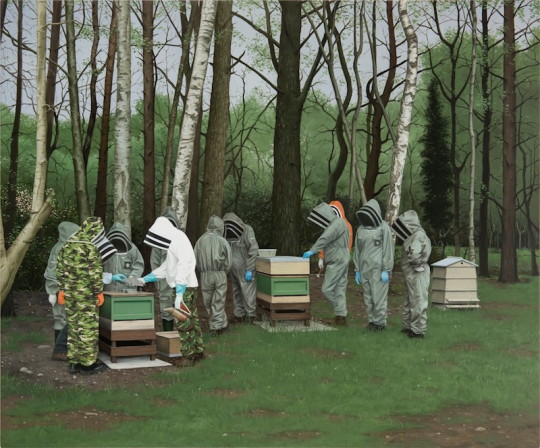
Wage War, 2016 Oil on wood panel 58x70cm
DoL Po, however, does feature DoL: Stark’s co-conspirators Rebecca and Mike have worked alongside as a provocative soundboard which might be thought of as the positive side of the division of labour: the ability it provides to bring various talents to bear in a joint production. The evident fruits of that are the double-sided painting Medium of Exchange , the painting Workers Hammer and this publication, which features the decidedly Po idea of a sandpaper dust jacket, imperilling any other book shelved alongside it. That, in turn, comes from Guy Debord’s Mémoires (1959), the ‘book to destroy all other books’ – discovered via the cover of the 1980 record The Return of the Durutti Column, which also borrowed the ploy. That’s typical of Stark, whose sources tend to blend horror films, gaming graphics, prog-rock album and sci-fi art with commerce, agriculture, politics, old master painting and the avant-garde, as if all belong together as readily as the internet suggests. So it is that he combines what may seem contradictory co-existents: witchcraft and spacecraft, bees and people, religion and superstition, capitalism, militarism and environmentalism.
The catalogue contains yet another somewhat unfashionable remnant of the last century: an excerpt from Steps (1968) by the Polish-American novelist Jerzy Kosinski (1933-91), remembered as much for his suicide under the clouds of illness and accusations of plagiarism, as for his writing. Steps explores social control and alienation and employs the distancing device of naming no characters or places. The Polish-born novelist’s work, largely emerging from his own experience as a child wandering war-torn Europe, can be characterised as survivalist.
In his words the ‘whole didactic point’ is ‘how you redeem yourself if you are pressed or threatened by the chances of daily life’. Kosinski emphasises the worth of individuals and how they form their own moral sense, but this often leads them to act at a remove from society – just such an action being evoked by the extract in which, after a violent rampage which wages war on the city ‘as if it were a living body’, the narrator is sufficiently sated to go to sleep in the morning, ‘smiling in the face of the day’.
Hold those four things in mind, then – the Division of Labour (negative and positive), Edward de Bono’s Po, oppositionality, Kosinski’s character seeking to liberate himself from convention and morality – and we’ll move on to what DoL Po’s paintings depict.
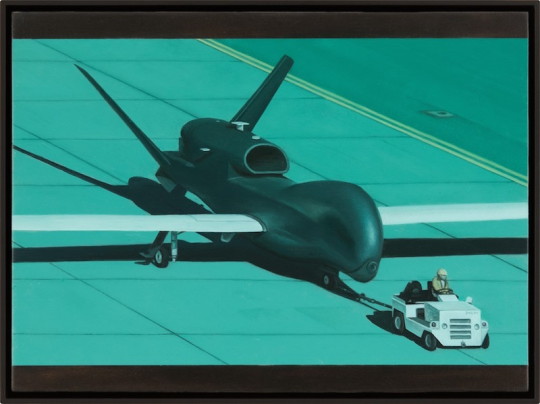
Vampyre, 2016 Oil on wood panel 21×28.5cm
Vampyre shows a military drone, seen as if through the night vision of a surveillance camera. That explains the rather poisonous ‘DoL Po green’. It’s framed – as are several other paintings – in a Brechtian manner which betrays its origin as a photograph which didn’t quite fit the shape of the computer screen (that’s all well and Po, though, as the consequent crop bars are a neat aesthetic echo of the shadow of the drone’s wings). What is military surveillance but an explicit version of the menace which lies behind all such scrutiny, from Bentham’s panopticon to CCTV? ‘Yes’, Stark concedes, ‘I have become the drone, scanning the internet to target images to appropriate.’ In which case he is also the vampyre, sucking the blood from our culture as he does so. Violence is built into the very act of observation.
Where else do you find drones? In the structured society of the bee colony of course, with its natural division of labour. The painting Wage War presents a version of Stark’s apiarists, faces obscured, a mysterious transaction going on, the protective suits remodelled to suggest youths in hoodies and soldiers in uniform. The title comes from the Kosinski excerpt, which was later lifted by Robert Calvert of Hawkwind fame and titled Wage War. It conflates the economic (‘we’re battling for a fair wage’) with the military (‘we’re going to war’). And what is that ceremonial laying on of hands? A honey sale agreed or the swearing of allegiance to a plot?
On the face of it, Workers Hammer depicts a signed and dated bone – presumably stolen from a museum – which could be used as a weapon in the wage war, but there’s no apostrophe in the lettering (lettering which is based on Albrecht Dürer’s typography, but with definite Nazi echoes). That means the title reads correctly as the action taken – ‘workers hammer bosses’, for example – rather than the object portrayed.
Invisible Hand is another reference to Adam Smith, this time to his theory that markets left to themselves would balance to an optimum point as if guided by an invisible hand. Now the phrase is applied to an automated operating theatre. Do we trust either of those unhuman forces? In fact, Stark says, this image is actually retro-futurist: it may be the way things will go, but the particular set-up shown here has already been replaced with the advancement of nanotechnologies. Perhaps there’s a link to the art of painting, which Stark effects with surgical precision. The thought of how an abstract expressionist surgeon might operate comes to mind for one queasy moment …
Exit could show the washroom facilities of any factory or office, but the reappearance of what now reads as radioactive green suggests a further site of decontamination. The subject may also recall its domestic equivalent: Hammershoi’s poised explorations of domestic interiors, typically featuring more portals than people. They, too, have a disquieting atmosphere, for all that they may look a long way from Kosinskian actions or nuclear meltdown.
A similar mix is evident in Nuke Descending. A pose from Duchamp is stymied by the absence of his depiction of movement, although that’s hinted at by indication of a scrolling screen. Assuming this is a place threatened by contamination, we see a robotic aided suit, used by the workers in the Fukushima Daiichi disaster: no wonder the red badge on the heart looks like the nuclear button. Military and scientific combine with the disturbing thought of how a nude body might be exposed.
The title of Flashpoint suggests that an emergency did occur. It zooms in on a firefighter in the employ of DoL Po, complete with CND sign ventilator, the number of angels and essence of the holy trinity (333) penned on the walkie-talkie, and praying hands embossed on the helmet, the visor of which becomes a tour de force of views seen through and reflected. Stark sees this as a Promethean figure, so taking us back to his theft of fire on behalf of mankind and subsequent suffering as eagles ate his ever-regenerating liver. No shortage of symbols here, then: what might be just a faceless portrait is awash with cosmic references and menace.
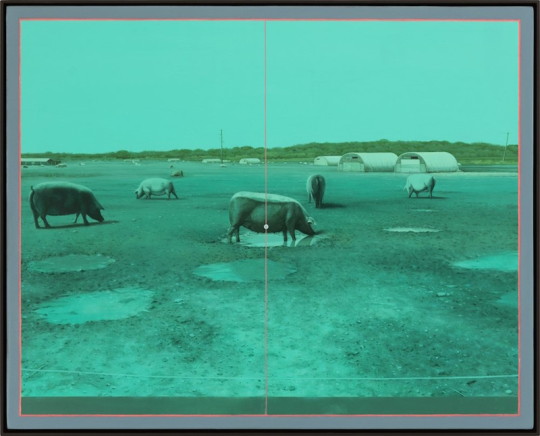
Harvest, 2016 Oil on wood panel 40x50cm
There are two paintings of pig farms. Stark lives in rural Suffolk, near the rapidly eroding coastline so the mid-winter view over Covehithe is a natural subject for him. Harvest combines ‘Preview’ crop lines and the night vision view finder of the drone to line up on a centred swine. The pigs are also dignified by the largest painting in the show, as would have been expected on Orwell’s Animal Farm, where the power was porcine. And indeed, Beasts of England takes its title from the anthem which expressed the original socialist-style pro-animal principles before the pigs took over as Orwell’s master race:
Rings shall vanish from our noses,
And the harness from our back,
Bit and spur shall rust forever,
Cruel whips no more shall crack …
Beasts of England, Beasts of Ireland,
Beasts of every land and clime,
Hearken well, and spread my tidings
Of the Golden future time.
Very fine sentiments, but we know the anthem will be replaced by a paean to the dictatorial hog, Napoleon:
Every beast big and small
Sleeps at peace in his stall,
Thou watchest over all,
Comrade Napoleon!
Finally, there’s the double-sided Medium of Exchange, which divides its labour between Stark, Rebecca and Mike. An apparently untenanted beekeeper’s glove in a trompe-l’œil alcove suggests another invisible hand. There could be a coin trick involved, or masonic symbolism, or some other system involving the alignment of the planets, hence the alternating words ‘Half Moon Inn’ and ‘Full Moon Out’. The paintings are presented to rise out of a monolith, hung back to back on a sheet of Plexiglas – as if a holy relic has landed, if not from another planet, then from 2001: A Space Odyssey. Though the two-sidedness and the wording strongly suggests a more quotidian pub sign.
So what does the unbridled whole amount to? ‘It is my intention’, Stark has said, ‘to express the transient nature of reality whilst exploring the shadows that humans cast upon it.’ If that’s the atmosphere nailed, consistent with that in Kosinski’s Steps, what’s the message? There’s a lot of detail here, and a lot of data, but even when we know what we’re looking at, there’s the sense that secrets remain to which we lack the key.
We probably need to take the hint, and apply the principle of Po, leaping forward with no fear for whether we are right or wrong. For example, is Stark asking whether we can find a point of stability in which people retain their integrity while machines do all the hard work? That might be our equivalent of Marx’s vision of the communist society. Is he suggesting what apparent contradictions lie behind the facades of our society? Might it be superstition behind Christianity? Surveillance behind technology? Medievalism behind science? Militarism behind capitalism? Or perhaps an analogy is being drawn between the way we are separated from each other and joined up differently by the move from analogue to digital worlds, with how the Division of Labour appeared to Thoreau and Marx. That would suggest an era in which new opportunities come at the price of a profound disconnection from our roots.
But we’ve probably got beyond expecting answers from artists. Perhaps we should finish on Stark’s way of painting, on the time he takes to control so exactly the elements in his dance of themes. That invests them with the value of his labour, elevates them and the questions they raise to a status worthy of the kind of attention we give to the grand narratives of classical painting.
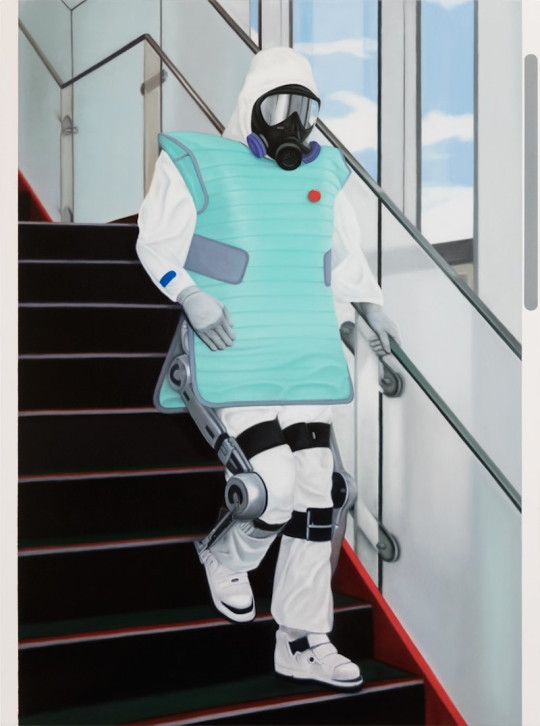
‘Nuke Descending’ John Stark 2016

